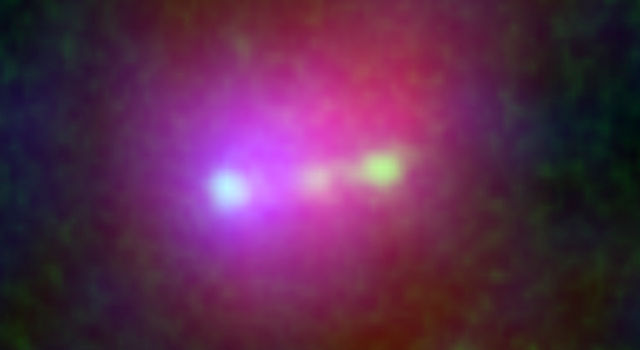Nov 22 2013
Astronomers using the combined power of the Atacama Large Millimeter/submillimeter Array (ALMA) telescope in Chile and NASA's Hubble and Spitzer space telescopes have discovered a far-flung trio of primitive galaxies nestled inside an enormous blob of primordial gas nearly 13 billion light-years from Earth. It's possible the trio will eventually merge into a single galaxy similar to our own Milky Way.
 The big blob-like structure shown here, named Himiko after the legendary ancient queen of Japan, turns out to be three galaxies thought to be in the process of merging into one. In this image, infrared data from NASA's Spitzer Space Telescope are red; visible data from NASA's Hubble Space Telescope are green; and ultraviolet data from Japan's Subaru telescope on Mauna Kea, Hawaii are blue.
The big blob-like structure shown here, named Himiko after the legendary ancient queen of Japan, turns out to be three galaxies thought to be in the process of merging into one. In this image, infrared data from NASA's Spitzer Space Telescope are red; visible data from NASA's Hubble Space Telescope are green; and ultraviolet data from Japan's Subaru telescope on Mauna Kea, Hawaii are blue.
"This exceedingly rare triple system, seen when the universe was only 800 million years old, provides important insights into the earliest stages of galaxy formation during a period known as 'cosmic dawn,' when the universe was first bathed in starlight," said Richard Ellis of the California Institute of Technology, Pasadena, a member of the research team.
Researchers first detected this object, which appeared to be a giant bubble of hot, ionized gas, in 2009. Dubbed Himiko (after a legendary queen of ancient Japan), it is nearly 10 times larger than typical galaxies of that era and comparable in size to our own Milky Way. Subsequent infrared observations with NASA's Spitzer Space Telescope provided more clues about the object's mass, suggesting Himiko might represent a single galaxy, which would make it uncharacteristically massive for that period of the early universe.
"The new observations revealed that, rather than a single galaxy, Himiko harbors three distinct, bright sources, whose intense star formation is heating and ionizing this giant cloud of gas," said Masami Ouchi, an associate professor at the University of Tokyo who led the international team of astronomers from Japan and the United States.
New data from ALMA, Hubble and Spitzer also led astronomers to speculate that Himiko could be made up almost entirely of primordial gas, a mixture of the light elements hydrogen and helium, which were created in the Big Bang event that gave birth to our universe. If correct, this would be a landmark discovery signaling the detection of a primordial galaxy seen during its formation.
The results are accepted for publication in the Astrophysical Journal.
Read the full ALMA news release online at: https://public.nrao.edu/news/pressreleases/infant-galaxies-merge-near-cosmic-dawn .
Read the Caltech news release at: http://www.caltech.edu/content/himiko-and-cosmic-dawn .
NASA's Jet Propulsion Laboratory, Pasadena, Calif., manages the Spitzer Space Telescope mission for NASA's Science Mission Directorate, Washington. Science operations are conducted at the Spitzer Science Center at Caltech. Spacecraft operations are based at Lockheed Martin Space Systems Company, Littleton, Colorado. Data are archived at the Infrared Science Archive housed at the Infrared Processing and Analysis Center at Caltech. Caltech manages JPL for NASA. For more information about Spitzer, visit http://spitzer.caltech.edu and http://www.nasa.gov/spitzer.
ALMA, an international astronomy facility, is a partnership of Europe, North America and East Asia in cooperation with the Republic of Chile. ALMA construction and operations are led on behalf of Europe by ESO, on behalf of North America by the National Radio Astronomy Observatory (NRAO), and on behalf of East Asia by the National Astronomical Observatory of Japan (NAOJ). The Joint ALMA Observatory (JAO) provides the unified leadership and management of the construction, commissioning and operation of ALMA.